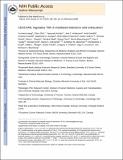| dc.contributor.author | Huang, Yu-Hwa | |
| dc.contributor.author | Zhu, Chen | |
| dc.contributor.author | Kondo, Yasuyuki | |
| dc.contributor.author | Anderson, Ana C. | |
| dc.contributor.author | Gandhi, Amit | |
| dc.contributor.author | Russell, Andrew | |
| dc.contributor.author | Dougan, Stephanie K. | |
| dc.contributor.author | Petersen, Britt-Sabina | |
| dc.contributor.author | Melum, Espen | |
| dc.contributor.author | Pertel, Thomas | |
| dc.contributor.author | Clayton, Kiera L. | |
| dc.contributor.author | Raab, Monika | |
| dc.contributor.author | Chen, Qiang | |
| dc.contributor.author | Beauchemin, Nicole | |
| dc.contributor.author | Yazaki, Paul J. | |
| dc.contributor.author | Pyzik, Michal | |
| dc.contributor.author | Ostrowski, Mario A. | |
| dc.contributor.author | Glickman, Jonathan N. | |
| dc.contributor.author | Rudd, Christopher E. | |
| dc.contributor.author | Franke, Andre | |
| dc.contributor.author | Petsko, Gregory A. | |
| dc.contributor.author | Kuchroo, Vijay K. | |
| dc.contributor.author | Blumberg, Richard S. | |
| dc.contributor.author | Ploegh, Hidde | |
| dc.date.accessioned | 2015-04-23T15:44:15Z | |
| dc.date.available | 2015-04-23T15:44:15Z | |
| dc.date.issued | 2014-10 | |
| dc.date.submitted | 2013-12 | |
| dc.identifier.issn | 0028-0836 | |
| dc.identifier.issn | 1476-4687 | |
| dc.identifier.uri | http://hdl.handle.net/1721.1/96739 | |
| dc.description.abstract | T-cell immunoglobulin domain and mucin domain-3 (TIM-3, also known as HAVCR2) is an activation-induced inhibitory molecule involved in tolerance and shown to induce T-cell exhaustion in chronic viral infection and cancers[superscript 1, 2, 3, 4, 5]. Under some conditions, TIM-3 expression has also been shown to be stimulatory. Considering that TIM-3, like cytotoxic T lymphocyte antigen 4 (CTLA-4) and programmed death 1 (PD-1), is being targeted for cancer immunotherapy, it is important to identify the circumstances under which TIM-3 can inhibit and activate T-cell responses. Here we show that TIM-3 is co-expressed and forms a heterodimer with carcinoembryonic antigen cell adhesion molecule 1 (CEACAM1), another well-known molecule expressed on activated T cells and involved in T-cell inhibition[superscript 6, 7, 8, 9, 10]. Biochemical, biophysical and X-ray crystallography studies show that the membrane-distal immunoglobulin-variable (IgV)-like amino-terminal domain of each is crucial to these interactions. The presence of CEACAM1 endows TIM-3 with inhibitory function. CEACAM1 facilitates the maturation and cell surface expression of TIM-3 by forming a heterodimeric interaction in cis through the highly related membrane-distal N-terminal domains of each molecule. CEACAM1 and TIM-3 also bind in trans through their N-terminal domains. Both cis and trans interactions between CEACAM1 and TIM-3 determine the tolerance-inducing function of TIM-3. In a mouse adoptive transfer colitis model, CEACAM1-deficient T cells are hyper-inflammatory with reduced cell surface expression of TIM-3 and regulatory cytokines, and this is restored by T-cell-specific CEACAM1 expression. During chronic viral infection and in a tumour environment, CEACAM1 and TIM-3 mark exhausted T cells. Co-blockade of CEACAM1 and TIM-3 leads to enhancement of anti-tumour immune responses with improved elimination of tumours in mouse colorectal cancer models. Thus, CEACAM1 serves as a heterophilic ligand for TIM-3 that is required for its ability to mediate T-cell inhibition, and this interaction has a crucial role in regulating autoimmunity and anti-tumour immunity. | en_US |
| dc.description.sponsorship | American Association for Cancer Research. Pancreatic Cancer Action Network | en_US |
| dc.language.iso | en_US | |
| dc.publisher | Nature Publishing Group | en_US |
| dc.relation.isversionof | http://dx.doi.org/10.1038/nature13848 | en_US |
| dc.rights | Article is made available in accordance with the publisher's policy and may be subject to US copyright law. Please refer to the publisher's site for terms of use. | en_US |
| dc.source | PMC | en_US |
| dc.title | CEACAM1 regulates TIM-3-mediated tolerance and exhaustion | en_US |
| dc.type | Article | en_US |
| dc.identifier.citation | Huang, Yu-Hwa, Chen Zhu, Yasuyuki Kondo, Ana C. Anderson, Amit Gandhi, Andrew Russell, Stephanie K. Dougan, et al. “CEACAM1 Regulates TIM-3-Mediated Tolerance and Exhaustion.” Nature 517, no. 7534 (October 26, 2014): 386–390. | en_US |
| dc.contributor.department | Massachusetts Institute of Technology. Department of Biology | en_US |
| dc.contributor.department | Whitehead Institute for Biomedical Research | en_US |
| dc.contributor.mitauthor | Ploegh, Hidde | en_US |
| dc.relation.journal | Nature | en_US |
| dc.eprint.version | Author's final manuscript | en_US |
| dc.type.uri | http://purl.org/eprint/type/JournalArticle | en_US |
| eprint.status | http://purl.org/eprint/status/PeerReviewed | en_US |
| dspace.orderedauthors | Huang, Yu-Hwa; Zhu, Chen; Kondo, Yasuyuki; Anderson, Ana C.; Gandhi, Amit; Russell, Andrew; Dougan, Stephanie K.; Petersen, Britt-Sabina; Melum, Espen; Pertel, Thomas; Clayton, Kiera L.; Raab, Monika; Chen, Qiang; Beauchemin, Nicole; Yazaki, Paul J.; Pyzik, Michal; Ostrowski, Mario A.; Glickman, Jonathan N.; Rudd, Christopher E.; Ploegh, Hidde L.; Franke, Andre; Petsko, Gregory A.; Kuchroo, Vijay K.; Blumberg, Richard S. | en_US |
| dc.identifier.orcid | https://orcid.org/0000-0002-1090-6071 | |
| mit.license | PUBLISHER_POLICY | en_US |
| mit.metadata.status | Complete | |
